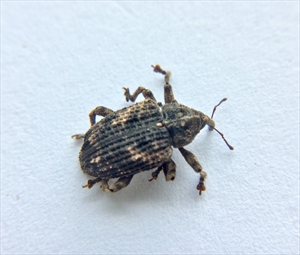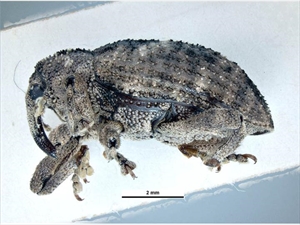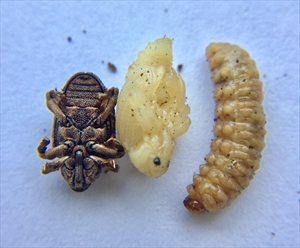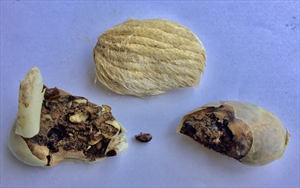Mango seed weevil, mango stone weevil, mango weevil
Pacific Pests, Pathogens and Weeds - Online edition
Pacific Pests, Pathogens & Weeds
Mango seed weevil (353)
Sternochetus mangiferae; previously, Cryptorhynchus mangiferae.
Asia, Africa, North, (Hawaii), South, and Central America, the Caribbean, Oceania. It is recorded from Australia (but not Western Australia), Fiji, French Polynesia, Guam, New Caledonia, Northern Mariana Islands, Tonga, and Wallis & Futuna.
Note, there is another mango weevil, the mango pulp weevil, Sternochetus rigidus, present in South and Southeast Asia, including Papua New Guinea (see Fact Sheet no. 437).
Mango
The damage is done by the larvae tunnelling into the seed. The pupae and adults also develop there.
The adults are 7.5-10 mm long and about 4 mm wide, with wing cases of variable colour: dark brown, black, grey, with light (yellowish) patches (Photo 1&2). The weevils are nocturnal. The adults hibernate during the non-fruiting period. In the Northern Territory of Australia, this is between December and mid-August. It has been suggested that periods of hibernation and activity are associated with day length. Hibernation ends when flowering and fruiting begins. At this time, the adults start to feed on leaves and shoots, mate and lay eggs.
Eggs are laid singly on young fruit (about 30 mm diameter), up to the stage when they are half mature. After laying an egg, the female weevil makes a slit in the fruit to release sap which covers the egg and "glues" it to the fruit. There may be several eggs on each fruit.
The eggs hatch and the larvae burrow through the flesh and into the seed, where they feed on the immature leaves (Photo 3). When mature, the larvae are up to 18 mm long. Pupation occurs in the seed, rarely in the flesh, and lasts about 7 days (Photos 4&5). The adult emerges by chewing through the seed coat up to 2 months after the fruit has fallen on the ground and the flesh has decayed. Usually, there is just one adult in each fruit. The life cycle from egg to adult is 5-8 weeks.
Spread is inside infested fruit transported for eating and propagation. Adults are not strong flyers. Survival during the winter months is in leaf litter, under bark, in the forks of branches, or within the seed. The adults do not move far from the tree where they developed, and this is the reason for "hot-spots" of the weevil within mango plantations.
The weevil does not cause significant loss of production, although it can increase fruit drop during early development, and reduce germination. In India, for instance, levels of infestation can be close to 90%. Further, there is little apparent damage to the flesh from tunnels made by the larvae; the tunnels close as the fruit expands, and are no longer seen at maturity.
However, the weevil remains a 'cosmetic' pest. Its presence affects fruit quality: consumers are unlikely to welcome fruit if (i) there are dark marks over the eggs on the surface of the fruit, or (ii) life forms of the weevil or frass are visible in the seed. Worse, in South Africa, weevils tunnel through the flesh of late maturing fruit attracting fungal infections. For these reasons, there are quarantine concerns between countries were the weevil is present and those yet free from infestation, and this affects trade.
Look for egg-laying on fruit; however, they may be difficult to detect because the eggs are covered by sap which solidifies. However, CAB1I reports that "... when populations are high, brown marks at the oviposition [egg-laying] sites on mature fruit are very obvious". Look for the different stages inside the seed by cutting it open.
QUARANTINE
Countries still free from the weevil|, or those that have areas recognised officially as free, and export the crops, should take all practical measures to prevent its introduction or further spread. The pest may spread as eggs, larvae, pupae, and adults within the flesh. Visual inspection of the fruit is not sufficient to determine infestation. If introduction and establishment of the weevil should occur, it may result in the termination of trade arrangements.
To contain the risk of further spread of the mango weevil, 'area freedom' should be used as a management strategy, following the guidelines of the International Standards for Phytosanitary Measures, Food and Agriculture Organization (FAO), Publication No. 10 Requirements for the establishment of pest free places of production and pest free production sites.
NATURAL ENEMIES
The weaver ant, Oecophylla smaragdina, is a predator of the weevil. No other natural enemies of the eggs or larvae have been recorded.
CULTURAL CONTROL
After harvest:
- Collect all fruit and seeds from the mango plantation and destroy them to reduce infestation levels for the next year.
- Have a policy banning mango fruit being brought onto commercial properties.
- If possible, remove all non-commercial mango trees on properties. If this is not possible, spray these trees with an insecticide (see below).
CHEMICAL CONTROL
Use insecticides when eggs are first seen on the fruit; one or two sprays should be sufficient. This is the time when the adults are active in the canopy. In Australia, organophosphate insecticides (chlorpyrifos and methidathion) are registered for use against the mango seed weevil. The commercial products that contain methidathion may also contain petroleum oils for the control of scale insects. Note that many organophosphate insecticides are potent nerve agents, and the World Health Organization (WHO) considers chlorpyrifos to be moderately hazardous (Class II). Methidathion is banned in the European Community. It is likely that synthetic pyrethroids would also be effective.
____________________
When using a pesticide, always wear protective clothing and follow the instructions on the product label, such as dosage, timing of application, and pre-harvest interval. Recommendations will vary with the crop and system of cultivation. Expert advice on the most appropriate pesticide to use should always be sought from local agricultural authorities.
AUTHOR Grahame Jackson & Mani Mua
Information from 1CABI Sternochetus mangiferae (mango seed weevil) (2017) Crop Protection Compendium. (https://www.cabi.org/cpc/datasheet/16434); and Woodruff RE, et al. (2014) Featured Creatures: Mango seed weevil. UF/IFAS, University of Florida. (http://entnemdept.ufl.edu/creatures/fruit/beetles/mango_seed_weevil.htm); and from DAF (2017) Mango seed weevil. Queensland Government. (https://www.daf.qld.gov.au/business-priorities/agriculture/plants/fruit-vegetable/insect-pests/mango-seed-weevil); and Chin D et al. (2010) Field guide to pests, beneficials, diseases and disorders of mangoes. Northern Territory Government, Department of Resources, Australia. (https://dpir.nt.gov.au/__data/assets/pdf_file/0006/227832/mango_field_guide.pdf). Photo 2 Ken Walker (2005) Sternochetus mangiferae: PaDIL - (http://www.padil.gov.au).
Produced with support from the Australian Centre for International Agricultural Research under project HORT/2016/185: Responding to emerging pest and disease threats to horticulture in the Pacific islands, implemented by the University of Queensland and the Secretariat of the Pacific Community.








